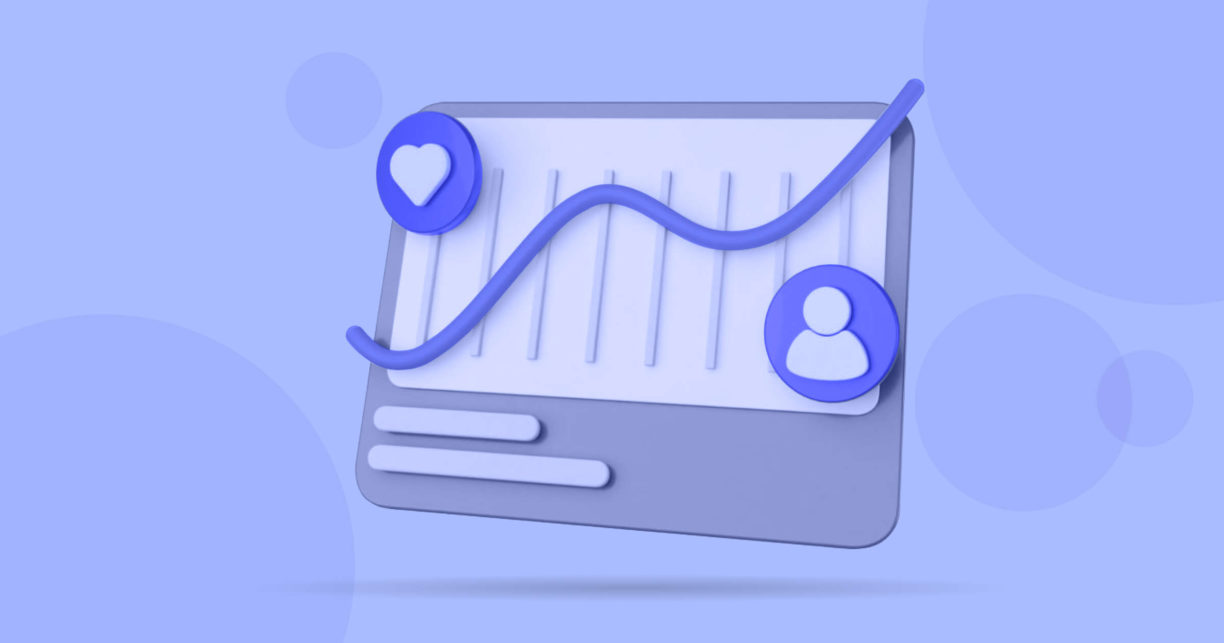Whereas brick-and-mortar stores can see their customers face to face, online businesses need other ways to get acquainted with their consumers. Therefore, they track user behavior on website resources with Google Analytics and other tools.
Even though Google Analytics is a primary way to see what people do on websites, it doesn’t show why they do it. That’s when you need to combine it with other website tracking tools like Hotjar, Verfacto, or Kissmetrics, for more meaningful insights.
Read this overview to discover the top website tracking software online businesses can benefit from.
55% of customers want to use rewards across multiple brands. The easiest way for growing brands to start such a loyalty program is Monetha - Loyalty & Rewards. Ready to try?
What is Website Tracking?
Website tracking is the process of gathering data on how users interact with a specific web resource. This information includes clicks, scrolls, session recordings, user visits, social media shares, and other activity that allows for tracking users.
Since the volume of user data to process is enormous, web marketers collect data with automated tracking tools. Such software automatically records all critical interactions and turns them into reports and visualizations.
How Does Website Tracking Work?
Every time you land on a site, it collects data from your web browser or device to personalize your experience and run faster. These details can also be used to monitor user activity.
Here are several most common online tracking technologies and how they work:
IP tracking. Website tracking tools use a unique IP (Internet Protocol) address of every internet connection to detect an approximate location. IP addresses help teams understand where their target audience is and segment visitors by location.
Cookies. Many web analytics solutions start tracking users by installing browser cookies. These small text files can identify a specific user when they navigate between site pages or different websites.
Tracking pixels. These tiny snippets of code measuring 1×1 pixels load via HTML to record when users open a web page or email.
Fingerprinting. Website tracking tools create a unique ID from visitor’s browser and computer settings to track their browsing activity.
Device tracking. Behavior analytics software gathers OS, browser, and device type information to track user behavior.
Combining these data collection approaches allows tracking tools to turn raw data into valuable insights. You can view real-time activity, use visualizations and graphs, download reports, and more.
Why is Website Tracking Important for eCommerce?
The main goal of user activity tracking is to identify what website visitors do to enhance their experience and boost conversions. By optimizing their websites through web analytics, ecommerce businesses get the following benefits:
1. Learn More About Your Target Audience
Tracking tools provide ecommerce businesses with information on what their potential buyers like and don’t like. For example, they can see what products people view the most often or when they stumble and bounce.
Web tracking details also include information about the user’s operating system, device type, location, and other data that can be used for segmentation (learn more about cross-device tracking here). Thanks to it, online businesses can gain insight into what user categories visit their web resources to customize their content and functionality accordingly.
2. Behavior Analytics Helps with Bug Fixing
When it comes to ecommerce, even the tiniest design flaw can repel leads and make them leave. User experience monitoring helps spot such issues and fix them as soon as possible. As a result, customer satisfaction increases, while website owners enjoy higher customer lifetime value and other KPI improvements.
3. Tracking Data Shows How to Boost Conversions
If an ecommerce website doesn’t perform as expected and conversion rates are low, web analytics software can help identify the reason. For example, it can show that there is a button that confuses users and distracts them from placing an order. The chances are that after you remove it, more leads will finish their conversion path. Since conversions directly affect the profitability of ecommerce stores, their growth equals increased revenue.
What Types of User Activity Can You Track?
Tracking data capabilities will depend on your website tracking software. Still, there are some basic data types most tools collect, such as:
User behavior and experience. Web analytics software allows you to monitor where individual users click, mouse movements, scroll depth, navigation patterns, session recording, and site speed.
Content performance. Tools track how people engage with your blog post content, social media, and other web resources to reflect your content marketing achievements. You can see the number of views, shares, and bounces.
CRO data. This data type is usually visualized as funnels. With specialized software, you can see what percentage of your leads convert and when they leave.
Besides, you can monitor user behavior through web surveys, chats, and A/B testing. A/B tests are particularly effective if you plan to change your website design and want to measure how people respond to a new version.
7 Tools to Track User Activity on Your Website
1. Google Analytics
Google Analytics is probably the first thing that comes to mind when you think about website monitoring. This popular tool gathers information on what search traffic comes to your website, allowing you to segment it by type. With Google Analytics, you can also learn page views, bounce rate, and average visit duration.
But note that if you want advanced website tracking, you must combine Google Analytics with tools that record individual user activity.
Best for: Collecting data on search traffic to your site
Pricing: Free
2. Google Optimize
Google Optimize (formerly Google Optimizer) is a web analytics and testing tool that allows marketers and webmasters to run experiments and compare different web page versions. You can see which option performs best based on custom objectives. Thanks to this, you can launch the site version that generates the highest conversion.
Best for: A/B testing different versions of website pages to pick the most effective one
Pricing: Free
3. Hotjar
Hotjar is a web tracking platform that combines multiple tools for marketers, designers, and product managers. You can see exactly how people interact with your site through website heatmaps displaying clicks, mouse movements, scrolls, and other interactions. Hotjar also supports videos showing how users navigate website pages and web surveys.
Best for: Tracking customer behavior on separate web pages to enhance product design
Pricing: Ranges from the free version to €79/month and up
4. Crazy Egg
Crazy Egg is a web platform that enables you to track users on a site through heatmaps, session recordings, A/B testing, traffic analysis, surveys, and error tracking. It also offers versatile reports and statistics that provide vital insight into visitors’ behavioral patterns.
Even though small companies can benefit from this website tracking tool, Crazy Egg is best suited for medium and large businesses. It also focuses on ecommerce companies and Shopify users, in particular, offering easy integration with Shopify.
Best for: Medium and large companies that want advanced web analytics functionality
Pricing: Ranges from $29 to 249 per month with a free 30-day trial for every plan
5. Kissmetrics
The Kissmetrics platform offers two products for tracking user behavior. While one tool is tailored for SaaS companies, another is perfect for ecommerce businesses. The data collected with the SaaS solution can help you convert more trials into paying customers, reduce churn rates, generate more revenue per customer, and increase the CLV. The tool for ecommerce helps increase purchases, optimize checkout, and grow revenue.
Best for: SaaS and ecommerce companies that want detailed customer reports and BI reporting
Pricing: Starts at $299/month
6. Plerdy
Plerdy is a conversion rate optimization platform with real-time heatmaps, mouse movement tracking, session recordings, sales performance reporting, and other valuable features like NPS forms. You can also connect it with Google Tag Manager to automatically set up custom events and monitor specific actions.
The data collected by this tool allows you to see what visitors click and how it affects conversions. You can enhance your website design and content based on this information to make more people convert.
Best for: Improving conversion rates on a site
Pricing: Free version or around $79/month and up
7. Verfacto
Verfacto is a tool that turns website visitors’ behavior into detailed customer profiles and marketing insights. You can learn the customer’s most converting channel, view a comprehensive website journey map, upload profiles to Klavyio, Facebook, and Google for advanced marketing, measure attention score, recency, frequency, lifetime value, and more. The best thing about Verfacto is the support of all top ecommerce platforms, including Shopify, WooCommerce, PrestaShop, Magento, and OpenCart.
Best for: Analyzing customer journey details on your site
Pricing: From the free version to $399/month
Can You Legally Track User Activity on Your Website?
Despite GDPR adoption (read more about GDPR for eCommerce here) and other laws that regulate user data processing, you can still lawfully collect valuable information about website visitors. Just don’t forget to inform users about information processing practices in your Privacy Policy and always request their consent before gathering data.
Besides, you need to ensure the third-party tool you use is GDPR-compliant and doesn’t record any extra details. Verfacto is one top option to consider.
Be Aware of GDPR and Country-Specific Regulations
Why is GDPR so critical? This comprehensive EU regulation requires organizations to process EU citizens’ data with maximum transparency and security. The penalties for violation may cost up to 10 million euros and severe reputational damage.
Compliance and customer data security are something any online business must achieve. Hence, if you track activity gathering data about EU citizens, always choose tools that follow GDPR requirements. If you operate in other regions, research local data-related regulations like CCPA for the US.
Get real-time answers on Verfacto
Verfacto helps you find answers to many user analytics questions while staying GDPR, CCPA, and PECR compliant. It also doesn’t collect personal data or use cookies, so you can finally stop irritating your visitors with banners.
With Verfacto, you can learn:
User attention score
Average order value of a customer (AOV)
Number of days since the last purchase
Customer lifetime value (LTV)
Number of sessions of a visitor across all devices
Number of days since the last visit
Visitor’s device preferences
Preferred channels of a visitor
High-value customers
Customers that are likely to return ordered goods
Customers that prefer waiting for bargains
Based on all these metrics, Verfacto generates real-time customer profiles, so you can use them to adjust your on-site marketing strategy. Also, you can send these profiles directly to your email client or ads platform for better targeting and segmentation.
Conclusion
User behavior tracking is essential for every online business that wants to grow conversions and enhance the on-site customer experience. Fortunately, modern tools make website monitoring easier than ever. You only need to pay several dollars per month and integrate the software to get details on what people do visiting your pages.
FAQs
Is it possible to record user activity on a website?
Yes. You can connect your site with website tracking tools to record how people behave after landing on your pages. The software automatically collects user behavior data and turns it into reports, visualizations, and other readable formats.
Can you track the activity of Users with JavaScript?
Yes. You can write a custom JavaScript front-end script to track how website users behave. The result will be limited compared to Google Analytics, but you can still learn time spent, clicks, scrolls, mouse hovers, user country, and key presses.
How can I track user time on a web page?
You can use Google Analytics to see the average time people spend on your website pages. Log into Google Analytics, go to Behavior > Site Content > All Pages to see the report with an average session, time on page, and other valuable details.

